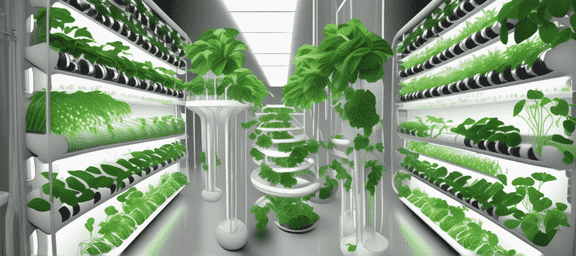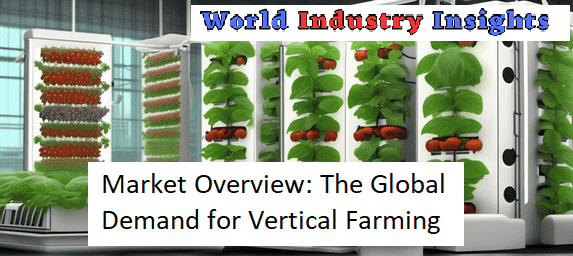Global Demand for Vertical Farming: Vertical farming is a game-changer for sustainable food production in today’s rapidly changing agricultural landscape. Modern agriculture relies on this innovative farming method, which has many advantages over traditional methods. Vertical farming is attracting farmers, investors, and policymakers worldwide.

Traditional Agriculture Issues
Population Growth, Limited Arable Land
Arable land shortages make traditional agriculture difficult. The global population is growing exponentially, putting pressure on farmland to produce food. Vertical farming allows controlled cultivation despite land scarcity.
Traditional Farming and Climate Change
Climate change has disrupted traditional farming practices with extreme weather events and changing weather patterns. Temperature swings, droughts, and pests have reduced crop yields. Vertical farming protects crops from environmental factors by providing a climate-controlled environment.
Sustainable Farming and Water Scarcity
Traditional agriculture is increasingly facing water scarcity. Hydroponics and aeroponics use much less water than conventional farming. Vertical farms reduce water use and waste with recirculation systems and precise nutrient delivery.
Knowing Vertical Farming
Vertical Farming Principles
Hydroponics, aeroponics, and aquaponics are used to grow crops vertically. Vertical farms maximize plant growth and productivity with artificial lighting, climate control, and nutrient delivery.
Vertical Farming’s Benefits a. Higher Crop Yield and Productivity
Vertical farming maximizes space by stacking growing beds vertically for multi-layered cultivation. Vertical integration boosts crop yield per square meter compared to traditional farming.
Land and Resource Efficiency
Vertical farms produce more crops on less land than traditional farms. Vertical farming maximizes land use while reducing environmental impact.
Transportation Cost and Carbon Footprint Reduction
Vertical farms near urban centers can grow produce locally, reducing transportation. Local production reduces transportation emissions and provides fresher produce.

Vertical Farming Technology
Vertical farming optimizes plant growth and resource use.
Hydroponics
Hydroponics feeds plants with nutrient-rich water. It eliminates soil, saves water, and allows precise nutrient delivery.
Aeroponics
Aeroponics suspends plant roots in a misted environment to directly supply oxygen and nutrients. This method boosts plant growth and water efficiency.
Aquaponics
Aquaponics is a fish-plant symbiosis. Fish waste feeds plants, which filter water, creating a self-regulating ecosystem.
CEA
CEA optimizes growth with artificial lighting, climate control, and humidity regulation. It allows year-round cultivation.
Vertical farming and AI
Automation and AI boost vertical farming productivity. Automated lighting, irrigation, nutrient delivery and data collection optimize plant growth. Data-driven AI algorithms optimize growing conditions in real time.
Sensors, IoT, and Analytics for Crop Optimization
Vertical farms monitor temperature, humidity, pH, and nutrient levels with sensors. IoT connects sensors for real-time data collection and analysis. Data analytics help farmers make data-driven decisions about plant health, growth patterns, and resource optimization.
Market trends and growth drivers
Population growth and food demand
Sustainable food production is needed to feed 9 billion people by 2050. Vertical farming’s ability to feed a growing population with limited resources makes it essential.
Urbanization Requires Local Food Production
Local produce is in demand due to rapid urbanization. Vertical farming’s compact design and urban integration allow it to produce fresh, nutritious food close to consumer markets.

Promoting Sustainable Farming
Sustainable food is in demand as consumers become more eco-conscious. Vertical farming’s resource-efficiency, pesticide reduction, and low carbon footprint support these sustainability goals.
AgTech Adoption Growing
Technology is helping agriculture become more productive. Vertical farming uses automation, AI, and data analytics to advance agricultural innovation.
Vertical farming government initiatives
Vertical farming could solve food and environmental issues, according to governments worldwide. Policies, grants, and funding are promoting vertical farming.
Regional market analysis
North America
Market size/growth potential, Vertical farming leaders, Government incentives.
Europe
Market trends and projections, Famous vertical farming companies, Vertical farming regulations and EU funding.
Asia Pacific
Asian vertical farming industry, Technological progress, Urban vertical farming demand.
Latin America
Vertical farming innovations, Climate and agricultural issues, Potential and investment.

Competition
Global Vertical Farming Leaders, Key players and industry contributions, Business models and vertical farming methods, Market share analysis, Industry Collaborations, Partnerships, and Acquisitions, Vertical farming company strategic alliances and partnerships, Technology and research collaborations, M&As and competitiveness, Market Opportunities and Challenges.
High Setup and Operating Costs
Vertical farming systems require significant initial and ongoing investment. Infrastructure, equipment, energy, and maintenance can cost investors. Technology and scale are lowering these costs.
Vertical Farming Regulations
Vertical farming regulations vary by country. To boost consumer confidence and market growth, food safety, organic certification, and labeling standards may need to be refined.
Low Consumer Awareness and Market Penetration
Consumers are still unfamiliar with vertical farming, despite its potential. Market penetration requires educating consumers about vertical farming’s benefits and value proposition.
Vertical farming for medicinal and non-food crops
Vertical farming is ideal for growing ornamental and medicinal plants in a controlled environment. Vertical farms can diversify revenue by exploring these opportunities.
Prospects
Market Prospects
Vertical farming is expected to grow rapidly worldwide. Food demand, technology, and environmental concerns are expected to drive market growth.
Future Innovations
Vertical farming research is expanding. Lighting, energy efficiency, and crop optimization using genetic engineering may be future innovations.
Vertical Farming and Food Security
Vertical farming contributes to global food security and sustainability by producing food sustainably, using fewer resources, and leaving a smaller footprint. It could significantly reduce dependence on traditional agriculture and mitigate climate change.

Conclusion of The Global Demand for Vertical Farming
Vertical farming’s ability to overcome agricultural challenges and offer many benefits is driving global demand. Technology, government support, and awareness will boost the market. Stakeholders and investors are encouraged to seize vertical farming’s opportunities to help secure a sustainable food future.
FAQs Related to The Global Demand for Vertical Farming
Q1. What is vertical farming?
Vertical farming is a method of cultivating plants in vertically stacked layers or structures, utilizing technologies like hydroponics or aeroponics, to optimize space and resource utilization.
Q2. What are the advantages of vertical farming over traditional agriculture?
Vertical farming offers increased crop yield, efficient land utilization, reduced water consumption, lower transportation costs, and a minimized carbon footprint compared to traditional farming methods.
Q3. How does vertical farming address water scarcity?
Vertical farming utilizes hydroponics or aeroponics, which significantly reduce water consumption compared to traditional soil-based farming. These methods recirculate water, minimizing waste and maximizing resource efficiency.
Q4. What are the growth drivers for vertical farming?
The rising global population and food demand, urbanization, increasing awareness of sustainable farming practices, growing adoption of advanced technologies in agriculture, and government support and initiatives all contribute to the growth of vertical farming.
Q5. What are the challenges of vertical farming?
High initial setup costs and operational expenses, regulatory hurdles, limited consumer awareness, and market penetration are some challenges faced by vertical farming. However, advancements in technology and increased education can help overcome these obstacles.
Our Reader’s Queries
What is the outlook for vertical farming industry?
The global vertical farming market is projected to grow significantly from 2022 to 2032. In 2022, the market was valued at 5.6 billion U.S. dollars, but it is expected to reach over 35 billion U.S. dollars by 2032. This growth is a clear indication of the increasing demand for vertical farming, which is a sustainable and efficient way of producing crops. With this projection, it is evident that the vertical farming industry is set to revolutionize the way we grow and consume food.
How big of an industry is vertical farming?
In 2022, the worldwide vertical farming market was valued at USD 5.89 billion, with projections indicating it will grow to USD 6.92 billion by 2023.
Is vertical farming becoming more popular?
As urbanization continues to rise and the global population grows, the vertical farming industry has been steadily expanding. In 2022, the market for vertical farming reached a staggering $5.6 billion and is projected to soar to over $35 billion by 2032, according to Statista. This growth trend is expected to continue as more people flock to urban areas and demand for locally grown produce increases.
Which country uses vertical farming the most?
The USA currently boasts the highest number of vertical farms, while Japan, China, Singapore, South Korea, Taiwan, and Thailand lead the industry in Asia. In Europe, Germany, France, UK, and the Netherlands are among the countries with vertical farms.

